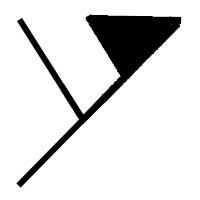Every clade must be defined by a unique characteristic. This is called a SYNAPOMORPHY. (a liberal translation would be: syn = shared, apo = derived, morphy = characteristic). This is exactly what a synapomorphy is - a characteristic that is shared among the members of the clade and which is evolutionarily derived. For example you have wide leaves and narrow leaves in a group, "wide" and "narrow" are character states.
Which one is derived?
To figure this out, you need an OUTGROUP.
An outgroup is the clade most closely related
to but not a part of the clade that you are analyzing.
The idea is that you have a group that you are
analyzing and its closest relative.

Because the group that your clade shares a common ancestor with the outgroup, the character state in that ancestor must be the primitive state. Thus, if there are two states in your clade and one of those is in the outgroup, that must be the primitive or basal state within your clade.